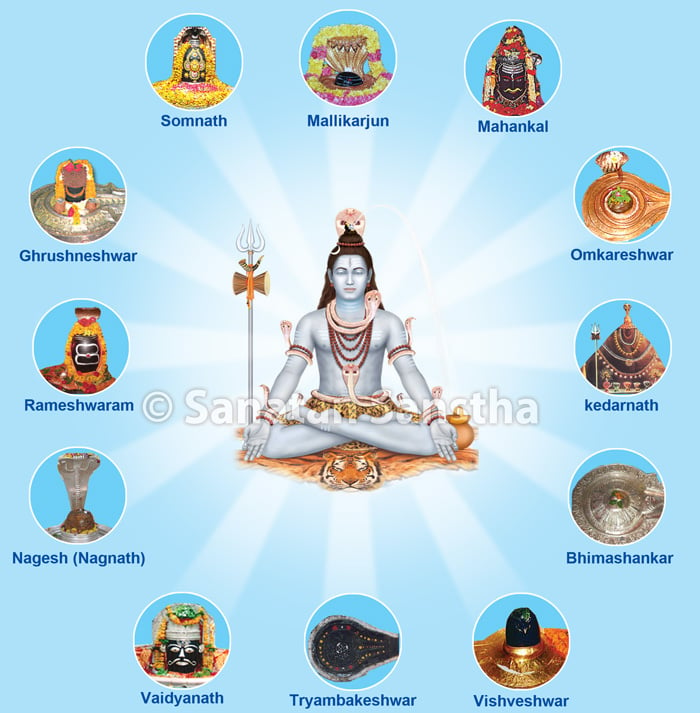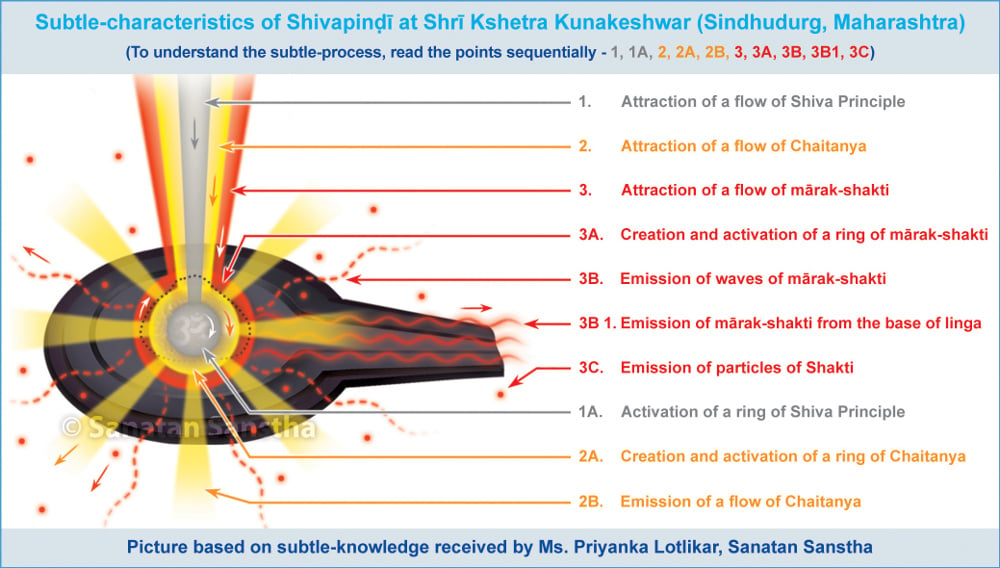
There are twelve Jyotirlingas and they are the major places of worship of Shiva. They materialised in a radiant form. The thirteenth pinda is known as the kalpinda. The pinda (Subtle body) which has crossed the limits of kal (Time), is known as kalpinda. The names of twelve Jyotirlingas are provided ahead.
| Jyotirlinga | Site |
|---|---|
| 1. Somnath | Prabhasapattan, near Veraval, Sourashtra, Gujarat |
| 2. Mallikarjun | Shrishailya, Andhra Pradesh |
| 3. Mahankal | Ujjain, Madhya Pradesh |
| 4. Omkar / Amaleshwar | Omkar, Mandhata, Madhya Pradesh |
| 5. Kedarnath | Himalayas |
| 6. Bhimashankar | Dakini region, Taluka Khed, District Pune, Maharashtra |
| 7. Vishveshwar | Varanasi, Uttar Pradesh |
| 8. Tryambakeshwar | Near Nashik, Maharashtra |
| 9. Vaidyanath (Vaijanath) (Note 1) | Parli, District Beed, Maharashtra |
| 10. Nagesh (Nagnath) (Note 2) | Darukavan, Oundh, District Hingoli, Maharashtra |
| 11. Rameshwaram | Setubandh, near Kanyakumari, Tamilnadu |
| 12. Ghrushneshwar (Ghrushnesh) | Verul, District Aurangabad, Maharashtra |
Note 1 – Variation : Baidyanathdham, Jharkhand
Note 2 – Variation : Almora, Uttar Pradesh
The twelve Jyotirlingas are the body and the Jyotirlinga at Pashupatinath in Kathamandu (Nepal) is the head over this body.
The meaning of a Jyotirlinga
1. The all-pervading Brahmatmalinga or all-pervading light.
2. In the Taittiriya Upanishad, the twelve Principles of Brahma, Maya, the jiva, the mind, intellect, subconscious mind, ego and the Panchamahabhutas have been referred to as the twelve Jyotirlingas.
3. The twelve sections of the Shivalinga.
4. In the Yadnyavedi (Pit where the ritual of sacrificial fires is performed), the shalunka represents the pit of the fire and the linga the flame of the fire.
5. A representation of the twelve Adityas (Species of Deities who are designated into groups).
6. The sites of eruption of fire from the dormant volcanoes. Since Yama, the master of southern direction is a subordinate of Shankar, south becomes the direction of Shankar. The Jyotirlingas are south-oriented, meaning, the opening of their shalunkas face southwards. Most temples do not face the southern direction. When the opening of the shalunka faces the south, its pinda possesses more spiritual energy; while the pinda with the opening of the shalunka facing north possesses lesser energy.
Spiritual significance
We should select an appropriate Jyotirlinga and perform Abhishek on that Jyotirlinga for example, Mahankal is charged with Tama predominant energy, Naganatha is in Harihar form and is Sattva-Tama-predominant and Tryambakeshwar is three components-oriented (also known as Avadhut).
The importance of Jyotirlinga’s and the place of samadhi of Saints
After taking samadhi, the work of Saints is more at the subtle level. Their bodies emit greater quantum of waves of Chaitanya and sattvikta. Just as the samadhi of a Saint is under the surface of earth, so also are the Jyotirlingas and swayambhu Shivalingas. Since these Shivalingas have greater amount of nirguṇtattva when compared with the other Shivalingas, they constantly emit greater quantum of nirguṇ Chaitanya and sattvikta. This helps in continuously purifying the atmosphere on the earth. Also, since these waves are constantly emitted towards the region of Hell, they are in continuous combat with the negative energies there. Hence, the earth is constantly protected from the attacks of powerful negative energies from the region of Hell.
Subtle drawing of Shivapindi at Kunakeshwar (Sindhudurg, Maharashtra)
Click on the below Subtle Drawing / Picture for a larger view !
Reference: Sanatan Sanstha’s Holy Text ‘Shiva’


